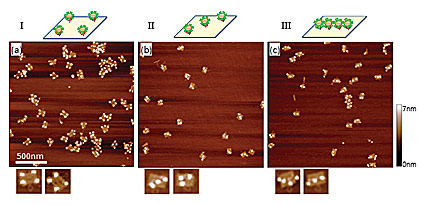In recent times, researchers are harnessing the molecular machinery of DNA for building nanolevel artificial structures using the pairing ability of DNA to form complicated structures. This “DNA origami” helps to assemble nanostructures like sensors, drug delivery system and semiconductor devices.
 "DNA origami: NIST researchers made three DNA origami templates designed so that quantum dots would arrange themselves: (a in the corners, b) diagonally (three dots), and (c in a line (four dots). The researchers found that putting the quantum dots closer together caused them to interfere with one another, leading to higher error rates and lower bonding strength."
"DNA origami: NIST researchers made three DNA origami templates designed so that quantum dots would arrange themselves: (a in the corners, b) diagonally (three dots), and (c in a line (four dots). The researchers found that putting the quantum dots closer together caused them to interfere with one another, leading to higher error rates and lower bonding strength."
Alex Liddle, a researcher at NIST, said that assembling is similar to LEGO building where some stick firm and tight, and others stick loosely.
In the DNA origami method, a long DNA thread is laid down and “staples” comprising complementary strands are attached. The staples bind to the DNA thread and then fold into different shapes like square, triangle and rectangle. These shapes will act as template to which nanoscale materials like quantum dots and nanoparticles are attached through linker molecules.
The scientists measured the speed, precision, spacing of the assembly, and the bonding strength of the nanoparticles to the DNA origami template.
The findings revealed that about 24 h is required for the self assembly of four quantum dots in a 70x100 nm origami rectangle. The error rate is around 5%.
The error rate was higher when the dots were placed in the center of the DNA origami template. The diameter can be increased by covering the dots with biomaterials. When the diameter is increased to 20 nm, the dots are not placed closely and they tend to interfere with each other while assembling. This will minimize the bonding strength and maximize the error rate. This is predominantly observed in four-dot patterns.
Liddle stated that this method can be efficiently applied for drug delivery and sensors. However, it cannot be applied to semiconductors due to higher distance and error rate.